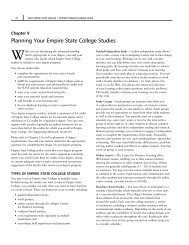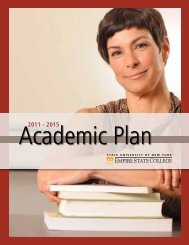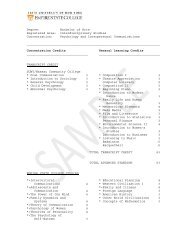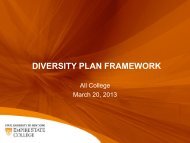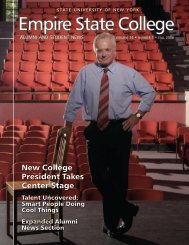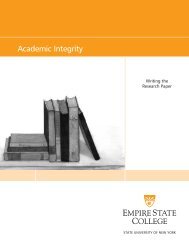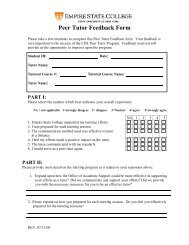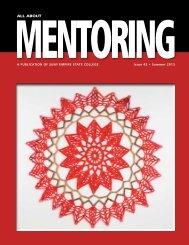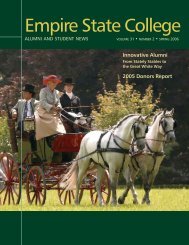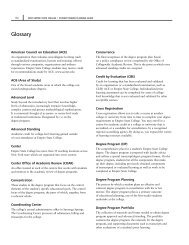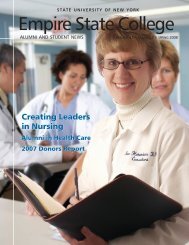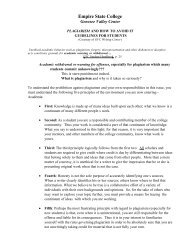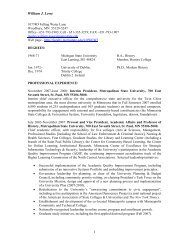All About Mentoring Spring 2011 - SUNY Empire State College
All About Mentoring Spring 2011 - SUNY Empire State College
All About Mentoring Spring 2011 - SUNY Empire State College
Create successful ePaper yourself
Turn your PDF publications into a flip-book with our unique Google optimized e-Paper software.
49<br />
win. Students read two Tim O’Brien short<br />
stories: “The Things They Carried” and<br />
“How to Tell a True War Story,” the latter,<br />
in particular, as a way to think about the<br />
idea of emotional truth and the casualty of<br />
truth in war. Also we asked the students to<br />
begin a journal that they were to maintain<br />
throughout the course as a place to sort out<br />
their reactions to the stories, videos, films<br />
and class discussions.<br />
When the study met for the first time, we<br />
handed each student a small plastic army<br />
guy – the kind most of us played with as<br />
kids – and asked students to use it as a<br />
writing prompt: What feelings and memories<br />
did it evoke in them What did such a figure<br />
represent to them now After writing, we<br />
asked students if they wanted to share what<br />
they wrote. We were surprised by two of<br />
our students who proclaimed, “These aren’t<br />
toys, these are instruments of war.” They<br />
went on to explain how they had kept these<br />
“toys” in their pockets at all times while<br />
they were deployed in Iraq and Afghanistan,<br />
as a way to communicate with the locals<br />
about the U.S. military maneuvers in a<br />
particular area. Because they did not share<br />
a common language, using the army guys<br />
allowed the soldiers to demonstrate<br />
their intentions.<br />
Module Two is War and the Media:<br />
Militainment. Since the media plays a<br />
major role in shaping our attitudes about<br />
war, we want students to look critically at<br />
some of the mainstream news sources (print<br />
and online) to get a sense of the range of<br />
information and opinions we are exposed<br />
to about the ongoing conflicts in Iraq and<br />
Afghanistan. Students begin their work<br />
by viewing and critically analyzing the<br />
documentary Militainment, Inc.: Militarism<br />
and Pop Culture which takes the position<br />
that the Pentagon and Hollywood have<br />
collaborated to depict war as entertainment.<br />
Next, they write an essay comparing and<br />
contrasting various media accounts of an<br />
event of their choosing related to the war<br />
in Iraq or Afghanistan. Abu Graib was<br />
a popular topic the first time we taught<br />
the study.<br />
Students collect information about the<br />
event from a liberal, conservative and<br />
international media source, and then apply<br />
specific critical thinking questions to help<br />
them come to their own reasoned conclusion<br />
about the information and the event. For<br />
some of the students, this “compare and<br />
contrast” assignment of looking at how<br />
events are portrayed in the media is truly<br />
eye-opening. They had no idea that the news<br />
is so slanted. One student wrote that she<br />
had not known that conservative and liberal<br />
When the study met for<br />
the first time, we handed<br />
each student a small<br />
plastic army guy – the<br />
kind most of us played<br />
with as kids – and asked<br />
students to use it as a<br />
writing prompt …<br />
perspectives were so dramatically different.<br />
Another student wrote that she’d come to<br />
understand that “decoding media claims”<br />
was daunting. Students came away from<br />
this assignment convinced of the importance<br />
of getting their news from more than one<br />
venue and to be on the alert for bias.<br />
Dick wrote:<br />
At times it seems that civilians see<br />
the military as a cohort of modern<br />
day gladiators whose exploits serve<br />
to entertain us. On TV we can watch<br />
live pictures of the wars in the Middle<br />
East. So called “reality programs”<br />
show carefully edited scenes of combat<br />
intended to excite but not offend the<br />
viewers. We can watch as Predators,<br />
flown by men and women who sit<br />
in Texas and “fly” the unmanned air<br />
vehicles through a laptop computer,<br />
bomb villages in Afghanistan. It seems<br />
that we are trying to make war into a<br />
kind of video game.<br />
For our in-class writing, we bring World<br />
War II propaganda posters to class and ask<br />
students to analyze the images and messages.<br />
They are surprised to discover how powerful<br />
the combination of images and words are in<br />
manipulating our emotions and promoting a<br />
particular notion of patriotism.<br />
What Is Heroism is our question for<br />
Module Three. Because heroism is so<br />
much the public face of war, and the label<br />
“hero” has become ubiquitous, we believe<br />
it important to ask students to think about<br />
what heroism means to them, and how our<br />
culture defines it. In that spirit, we listened<br />
to Staff Sergeant Barry Sadler’s Vietnam War<br />
anthem “The Ballad of the Green Berets,”<br />
and we read and discuss the biographies<br />
and poetry of World War I soldiers Siegfried<br />
Sassoon and Wilfred Owen. Students<br />
are also asked to read “The Banality of<br />
Heroism” by Franco and Zimbardo.<br />
Chris, a student who had recently served<br />
in Iraq, was particularly taken with<br />
Sassoon’s struggle:<br />
Siegfried Sassoon was an interesting<br />
writer. I was surprised by the letter<br />
he wrote that told his superiors of his<br />
feelings that the war was not win-able.<br />
The words he wrote to his commanding<br />
officer saying “I am a soldier speaking<br />
for soldiers … I am making the<br />
statement as an act of willful defiance<br />
of military authority … I can no longer<br />
be a party to prolong these sufferings<br />
… The ends I believe to be evil and<br />
unjust” were very powerful words. I<br />
believe this was important to our class<br />
because it showed that soldiers in a war<br />
are often very conflicted about it, or<br />
even adamantly against it.<br />
In this module, students were asked to<br />
view the films Glory! and Hurt Locker and<br />
decide which of the characters are heroic<br />
and why. Paul wrote:<br />
… there are very few who have the<br />
desire to volunteer this courage, bravery<br />
and honor before they are called to do<br />
so. The word hero is sometimes very<br />
loosely thrown around; it is not a label<br />
because a label can easily be removed.<br />
To be a hero is a title, something that<br />
you have earned and something that<br />
never goes away unless it is replaced by<br />
something nobler.<br />
Module Four is dedicated to The<br />
Homefront. It was important to us to<br />
provide students the opportunity to consider<br />
how war affects those at home, especially<br />
children. We use short stories by Pirandello,<br />
Faulkner, Alcott and essays from Operation<br />
suny empire state college • all about mentoring • issue 39 • spring <strong>2011</strong>




